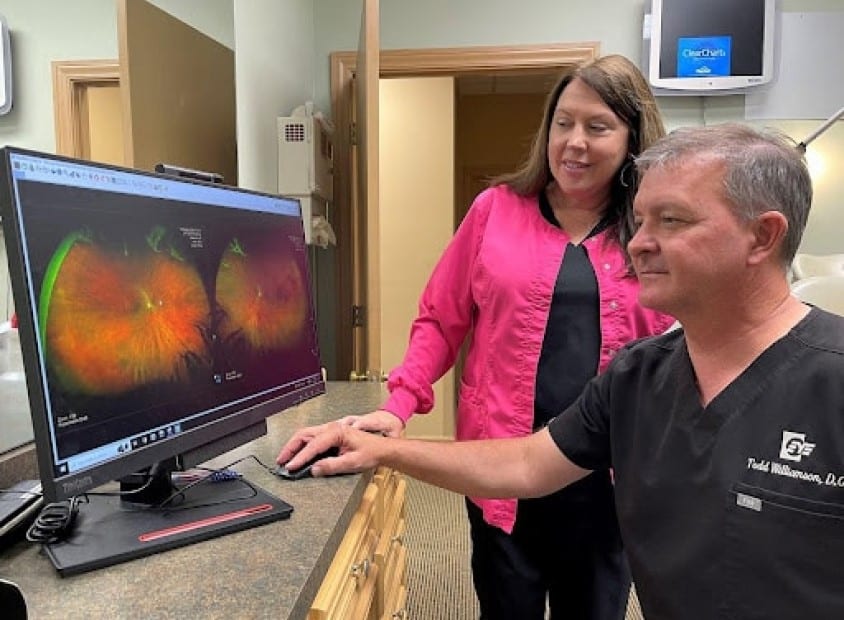
When Lawrie Wallace noticed her vision getting blurry, she underwent an eye exam. The results confirmed her fears—she had a cataract.
That would be a concern for anyone, but more so for Wallace: A childhood accident had already left her blind in one eye. Now, she faced losing sight in her other good eye.
“I was scared, especially about surgery,” says Wallace. “I was terrified that something would go wrong and I would be totally blind.”
But her surgeon, Dr. Todd Williamson, and the Hattiesburg Eye staff assured her that her chances for a good outcome were high. Indeed, Wallace came through the surgery with flying colors.
“It’s amazing,” says Wallace. “I can see clearly now, and I can view my computer without glasses.”
Had Wallace lived in a bygone era, her odds for a happy outcome might have been lower. But, as eye care providers like Hattiesburg Eye Clinic recognize during June’s Cataract Awareness Month, the vast majority of today’s cataract patients not only recoup the vision they’ve lost, but many may even see better than when they were younger.
This all revolves around a condition we all face to some degree as we age, as the natural lenses of the eyes become clouded. Each person is different—some may not experience any symptoms until much later in life, while occurring much earlier in others.
Cataract formation gradually leads to symptoms similar to those of Lawrie Wallace, including blurriness, “haloes” around nighttime headlights, or colors fading. And it’s not just an inconvenience: Untreated, cataracts can result in severe visual impairment or blindness.
The standard approach for treating a cataract hasn’t changed in decades: remove the clouded lens and replace it with an artificial lens called an intraocular lens (IOL). But the treatment technology has changed—dramatically.

“Today’s procedures are light years ahead of the way cataract surgery was performed thirty years ago,” says Dr. Williamson. “As a result, it’s become a very safe procedure with a very high success rate.”
The biggest leap forward in cataract surgery is the emerging use of lasers. While surgeons still employ the traditional scalpel technique, many like Dr. Williamson prefer making the incisions for removing a cataract with laser light. Laser procedures have a greater degree of precision, which allows for greater patient comfort and more accurate IOL placement.
Hattiesburg Eye Clinic has led the way in cataract laser treatment as the first vision care provider in Mississippi to implement the CATALYS® Precision Laser System. Built exclusively for cataract treatment, CATALYS® automates many of the surgical steps.
“We’ve been using CATALYS® for several years, and it has been well-worth it,” says Dr. Williamson. “It allows us to perform the majority of a procedure in under a minute. It’s also gentler on the patient, which allows for quicker recovery.”
Hattiesburg Eye Clinic was among the first in the nation in the other area of treatment development—more advanced IOLs.
“We now offer an array of lens implants that help us to better serve the needs and desires of individual patients,” says Dr. Williamson. “Our Toric lenses can correct astigmatism, which may reduce a patient’s need for glasses after surgery. And, our multifocal lenses like the TECNIS Symfony® can improve a patient’s ability to see at various ranges of distance, possibly without the need for glasses.”
These advances Hattiesburg Eye Clinic now offers made all the difference for Lawrie Wallace’s vision, and for her peace of mind.
“The improvement in my sight has simply been amazing,” says Wallace. “I can say for me, it’s been a miracle.”
You can see Lawrie’s story here www.youtube.com/watch?v=5xcEOiA06zw.
And, learn more about cataract treatment at www.hattiesburgeyeclinic.com/services/cataracts/
Or schedule a consultation at www.hattiesburgeyeclinic.com/contact-us/ or call 601-268-5910 (or toll-free 800-624-8254).


